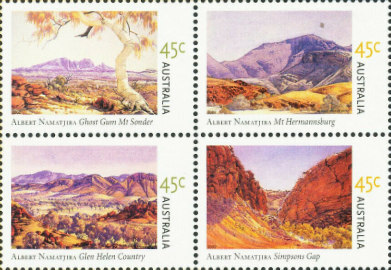History
Timeline results for
Found 1175 results for your search. Showing page 29 of 59.
2002
-
Australia Post celebrates a centenary since the birth of Aboriginal artist Albert Namatjira on 28 July, 1902. He was the first Aboriginal artist to exhibit his work professionally and paint in a Western style.

Albert Namatjira's signature style features desert landscapes of Central Australia.
2003
-
The Ministerial Council for Aboriginal and Torres Strait Islander Affairs (MCATSIA) commissions and releases an independent evaluation of government and non-government responses to the Bringing Them Home Report.
-
The Aboriginal and Torres Strait Islander Social Justice Commissioner publicly criticises the failure of governments to provide financial and social reparations for members of the Stolen Generation, a national apology, or the appropriate mechanisms for individuals that were forcibly removed to reconnect with their culture.
-
The Edinburgh Museum, Scotland returns remains that were dug up from burial grounds in South Australia.
-
Linda Burney (Australian Labor Party), is the first Aboriginal person elected to the New South Wales Parliament. She represents the electorate of Canterbury.
-
Royal College of Surgeons, Dublin hands over 60 Aboriginal human remains to Aboriginal representatives, who had travelled to Ireland to collect the remains and return them to Australia [1].
-
Australia Post issues a set of stamps that celebrates the Papunya Tula school of art. The set shows four of the many artists: Ningura Napurrula (Pintupi, born c. 1938; $1.10), Naata Nungurrayi (Pintupi, born c. 1932; $1.65), Graham Tjupurrula (Pintupi, born 1975; $2.20) and Dini Campbell Tjampitjinpa (Pintupi, c.1945-2000; $3.30). All paintings are untitled.

The stamps show four paintings of artists of the Papunya Tula art movement. -
The Museum Victoria returns the remains of an Aboriginal baby girl nicknamed 'Jaara Baby' to her modern-day relatives, the Dja Dja Wurrung people of north-west Victoria, 99 years to the day after they were found in a tree trunk by a woodcutter.
2004
-
The Commonwealth Government establishes a memorial to the Stolen Generations at Reconciliation Place in Canberra.
-
461 'Sorry Books' recording the thoughts of Australians on the unfolding history of the Stolen Generations are inscribed on the Australian Memory of the World Register, part of UNESCO's programme to protect and promote documentary material with significant historical value.
-
The government starts using Shared Responsibility Agreements (SRAs), voluntary written agreements, which set out outcomes to be achieved and the agreed roles and responsibilities of governments and Aboriginal communities in relation to particular projects or activities.
-
The Commonwealth government establishes a memorial to the Stolen Generations at Reconciliation Place in Canberra.
-
The National Indigenous Council is appointed to be an advisory body to the Australian government, chaired by Dr Sue Gordon, a Western Australian Magistrate. It winds up in early 2008.
-
Michael Long, a former Australian Rules footballer of partial Aboriginal decent, sets out on foot from Melbourne to Canberra to speak to Prime Minister John Howard and raise awareness of the plight of Aboriginal Australians. His walk becomes known as The Long Walk.
-
The New South Wales government apologises for the stolen wages and entitlements which occurred under the 1909 Aborigines Protection Act and subsequent laws until 1969.
I take this opportunity to formally apologise to the Aborigines affected and offer the assurance that any individual who can establish they are owed money will have it returned.
— Bob Carr, NSW Premier [2] -

Skull of an indigenous person (Andaman Islands). Many Indigenous remains like these are still held in museums all over the world. Lack of cultural sensitivity or museum personnel impede their examination and return. Museum of Ethnography, Stockholm, Sweden sends back 20 Aboriginal skeletons it had collected in 1910-11 from the Kimberley, Western Australia [3], the first voluntary repatriation undertaken by a major European museum [4].
-
Mulrunji Doomadgee dies in a police watch house on Palm Island, 70 km north of Townsville in north Queensland. His death sparks violent riots during which the police station and officers’ quarters are burnt down. Senior Sergeant Chris Hurley is found guilty of causing Mulrunji’s death, but in late 2006 Queensland’s Director of Public Prosecutions, Leanne Clare, opts not to prosecute him. In February 2007 the Premier Peter Beattie orders a judicial review of the case and Hurley is charged with manslaughter, the first time ever in Queensland
that a police officer is charged over the death of an Aboriginal person. In June 2007 an all-white jury finds him not guilty. Hurley returns to work after having been suspended on full pay. An Aboriginal man, Lex Wotton, was found guilty on 24 October 2008 of “rioting with destruction” and sentenced to six years in prison. -
Casey Donovan, at just 16 years of age, becomes the youngest and first female winner of Australian Idol. She releases Listen to Your Heart a few days later.
-
The Minister for Community Services, Carmel Tebbutt, announced that the NSW government would establish an Aboriginal Trust Fund Repayment Scheme (ATFRS). It will repay wages or other money that was paid into the Trust Funds between 1900 and 1968 and never repaid.
2005
-
The organisation Stolen Generations Victoria is set up as a result of the 2003 report of the Stolen Generations taskforce. Its purpose is to establish a range of support and referral services that will assist Stolen Generation peoples to reconnect with their family, community, culture and land.
References
View article sources (4)
[1]
'Aboriginal Remains Return Home', Indigenous Law Bulletin 23/2003, www.austlii.edu.au/au/journals/ILB/2003/23.html
[2]
Aboriginal Trust Fund Repayment Scheme information sheet, State Records Authority of New South Wales
[3]
'Aboriginal remains home from Sweden', National Museum of Australia, 6/10/2004, www.nma.gov.au/media/media_releases_by_year/2004/2004_10_06
[4]
'Putting it right', Koori Mail 466 p.43f


.jpg)